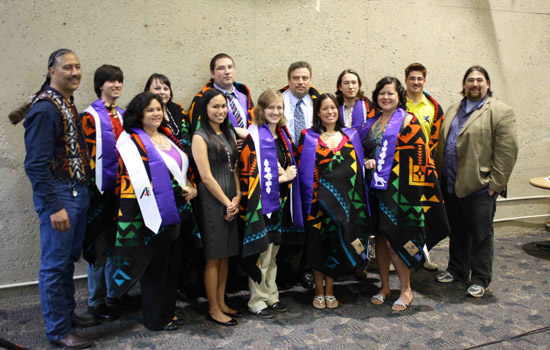RIT Recognized as a Top College for Native Americans
University has placed on national list for four consecutive years
Provided by the Future Stewards Program
RIT was recognized as one of the top 200 colleges in the U.S. for Native American students. One of the keys to that success is the Future Stewards Program. Each year, students who participate in the program and who will graduate from RIT are recognized in an honoring ceremony like this one from the 2011-2012 academic year.
For the fourth year in a row, Rochester Institute of Technology has been named as one of the country’s top educational options for Native American students.
The American Indian Science and Engineering Society named RIT as one of America’s Top 200 Colleges for Native Americans. The list appears in the annual college guide of the society’s Winds of Change magazine.
The university is being recognized for its academic programming and support services for Native American scholars, its cooperative relationships established with New York state tribes and leaders, and several research initiatives specific to Native American communities in the region.
“It is an honor to be recognized and an affirmation and motivation for our continued work to support Native student success while at RIT and beyond,” says Nizhoni Chow-Garcia (Navajo Nation), co-director of RIT’s Future Stewards Program, established in 2007 to provide academic, social, community and career services for the university’s Native American and First Nations scholars.
In its first year, 32 students were enrolled. Today, more than 142 participate in its campus-wide programs. They have an average GPA of 3.12 and more than 93 percent of those participants graduated from RIT with bachelor’s or master’s degrees since the program’s inception. This percentage is well above the national average of 39 percent of American Indian/Alaska Native students completing college degrees, according to the U.S. Department of Education.
As part of RIT President Bill Destler’s directive, the Future Stewards Program facilitated a strategic partnership between RIT and Native American, Alaska Native and First Nation governments and communities, known as the Native American Advisory Council. The council directly advises the president in an effort to identify the academic needs and challenges of Native American students. This summer, the council met at the Onondaga Nation, located just south of Syracuse, N.Y., and with the members of the Haudenosaunee Grand Council. Destler and several of his cabinet members also met with the Grand Council and leaders from each of the six tribal nations in New York state to explore opportunities and develop a lasting relationship.
“The meeting was an earnest and educational experience. It was a privilege to address North America’s oldest democracy and to better understand the challenges they still endure,” Destler says. “Relationships of substance are not entered into hastily—they take time to build and earn trust. We still have much to learn.”













